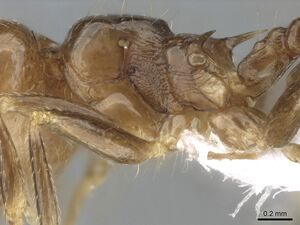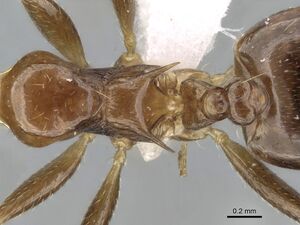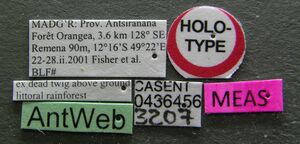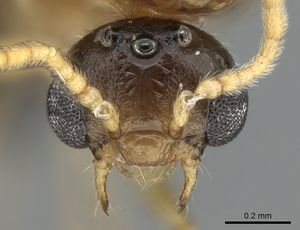Crematogaster tavaratra
| Crematogaster tavaratra | |
|---|---|

| |
| Scientific classification | |
| Kingdom: | Animalia |
| Phylum: | Arthropoda |
| Class: | Insecta |
| Order: | Hymenoptera |
| Family: | Formicidae |
| Subfamily: | Myrmicinae |
| Tribe: | Crematogastrini |
| Genus: | Crematogaster |
| Species: | C. tavaratra |
| Binomial name | |
| Crematogaster tavaratra Blaimer, 2013 | |
Crematogaster tavaratra is known only from two dry deciduous forests in the very far north of Madagascar, Reserve Analamerana and Foret d’Orangea, at elevations between 602225 m.This species co-occurs with Crematogaster kelleri at the first locality. Colony collections of C. tavaratra were made from dead branches and suggest that this species nests arboreally. (Blaimer and Fisher 2013)
Identification
A member of the Crematogaster kelleri group. Blaimer and Fisher (2013) - Workers of Crematogaster tavaratra can be separated from Crematogaster kelleri by the distinct longitudinal impression on the postpetiole (incomplete in the latter). The species does not co-occur with any of the other species (Crematogaster madagascariensis, Crematogaster hazolava, Crematogaster hafahafa) in the C. kelleri-group, but could not otherwise be confused given the distinctly longer propodeal spines and the position of the propodeal spiracle below and not confluent with the spine base. Queens of C. tavaratra can be separated easily from other (known) queens of the C. kelleri-group by their distinct longer spines (SPI 0.09–0.10; compared to C. kelleri and C. hazolava SPI 0.00–0.07).
Keys including this Species
- Key to Crematogaster kelleri group males
- Key to Crematogaster kelleri group queens
- Key to Crematogaster kelleri group workers
Distribution
Latitudinal Distribution Pattern
Latitudinal Range: -12.16° to -12.808889°.
| North Temperate |
North Subtropical |
Tropical | South Subtropical |
South Temperate |
- Source: AntMaps
Distribution based on Regional Taxon Lists
Malagasy Region: Madagascar (type locality).
Distribution based on AntMaps
Distribution based on AntWeb specimens
Check data from AntWeb
Countries Occupied
| Number of countries occupied by this species based on AntWiki Regional Taxon Lists. In general, fewer countries occupied indicates a narrower range, while more countries indicates a more widespread species. |

|
Estimated Abundance
| Relative abundance based on number of AntMaps records per species (this species within the purple bar). Fewer records (to the left) indicates a less abundant/encountered species while more records (to the right) indicates more abundant/encountered species. |

|
Biology
Castes
Worker
Images from AntWeb
     
| |
| Holotype of Crematogaster tavaratra. Worker. Specimen code casent0436456. Photographer Estella Ortega, uploaded by California Academy of Sciences. | Owned by CAS, San Francisco, CA, USA. |
Queen
Images from AntWeb
    
| |
| Queen (alate/dealate). Specimen code casent0317694. Photographer Estella Ortega, uploaded by California Academy of Sciences. | Owned by CAS, San Francisco, CA, USA. |

| |
| Male (alate). Specimen code casent0110524. Photographer Estella Ortega, uploaded by California Academy of Sciences. | Owned by CAS, San Francisco, CA, USA. |
Male
Images from AntWeb
    
| |
| Male (alate). Specimen code casent0110524. Photographer Estella Ortega, uploaded by California Academy of Sciences. | Owned by CAS, San Francisco, CA, USA. |
Nomenclature
The following information is derived from Barry Bolton's Online Catalogue of the Ants of the World.
- tavaratra. Crematogaster tavaratra Blaimer, in Blaimer & Fisher, 2013a: 23, figs. 28, 29 (w.q.m.) MADAGASCAR.
- Type-material: holotype worker, 4 paratype workers.
- Type-locality: holotype Madagascar: Prov. Antsiranana, Forêt Orangea, 3.6 km. 128° SE Remena, 90 m., 12°16’S, 49°22’E, 22-28.ii.2001, BLF3207 (B.L. Fisher, et al.); paratypes with same data.
- Type-depositories: CASC (holotype); MCZC, MHNG, SAMC, UCDC (paratypes).
- Distribution: Madagascar.
Unless otherwise noted the text for the remainder of this section is reported from the publication that includes the original description.
Description
Worker
(n =13) [holotype]. HW 0.83–1.03 [0.96]; HL 0.73–0.93 [0.86]; EL 0.15–0.22 [0.20]; SL 0.70–0.83 [0.78]; WL 0.90–1.12 [1.07]; SPL 0.17–0.27 [0.23]; PTH 0.17–0.21 [0.21]; PTL 0.25–0.29 [0.28]; PTW 0.25–0.30 [0.29]; PPL 0.17–0.20 [0.17]; PPW 0.23–0.29 [0.29]; LHT 0.71–0.91[0.86]; CI 1.11–1.16 [1.11]; OI 0.19–0.25 [0.23]; SI 0.86–0.99 [0.90]; SPI 0.17–0.24 [0.21]; PTHI 0.60–0.85 [0.74]; PTWI 0.91–1.19 [1.02]; PPI 1.28–1.68 [1.67]; LBI 1.18–1.27 [1.24].
Small to medium-sized species (HW 0.83–1.03, WL 0.90–1.12), with general characters of the C. kelleri-group and the following refinements.
Masticatory margin of mandibles with five teeth; posterior margin of head in full face view laterally subangular, often medially slightly depressed; midline of eyes situated above midline of head in full face view.
Lateral borders of mesonotum subangulate, posterolateral denticles absent; promesonotum planar, posterior face of mesonotum sloping into metanotal groove at ca. 45u angle; propodeal spines medium-sized (SPI 0.17–0.24), spiniform, straight, moderately diverging in dorsal view; propodeal spiracle situated distinctly below and not confluent with base of propodeal spines; petiole suboval to moderately flared, dorsolateral not carinulate, but with minute posterolateral denticles bearing paired erect setae; subpetiolar process developed into an acute tooth; median postpetiolar impression deep, clearly bisecting postpetiole into two lobes.
Face with 8–14 erect, long, flexuous setae; promesonotum usually with eight to ten long, flexuous setae: four to six pronotal setae, and two lateral setae each on dorsal and posterior face of mesonotum; abdominal tergites and sternites four through seven with abundant long erect pilosity, and short appressed to decumbent pubescence throughout. Color either yellow or dirty-orange with abdominal segments four through seven brown or black colored, or uniformly brown.
Queen
(n= 5). HW 1.38–1.45, HL 1.18–1.25, EL 0.36–0.40, SL 0.87–0.95, MSNW 1.13–1.18, MSNL 1.24–1.30, WL 2.26–2.34, SPL 0.19–0.24, PTH 0.32–0.38, PTL 0.42–0.47, PTW 0.49–0.55, PPL 0.31–0.35, PPW 0.39–0.52, LHT 1.07–1.13, CI 1.11–1.20, OI 0.30–0.32, SI 0.72–0.77, MSNI 0.87–0.96, SPI 0.09–0.10, PTHI 0.67–0.86, PTWI 1.03–1.31, PPI 1.13–1.61, LBI 2.06–2.16.
Medium size (HW 1.38–1.45, WL 2.26–2.34), with characters of the C. kelleri-group in addition to the following.
Masticatory margin of mandibles with five teeth; antennal scapes reaching or slightly surpassing head margin; eyes situated at midline of head in full face view.
Metanotum projecting from below scutellum in dorsal and lateral view; propodeal spines longer and spiniform (SPI 0.09–0.10).
Male
(n =1). HW 0.63, HL 0.46, EL 0.26, SL 0.11, MSNW 0.77, MSNL 0.69, WL 1.18, SPL 0.00,PTH 0.19, PTL 0.21, PTW 0.21, PPL 0.16, PPW 0.21, LHT 0.65, CI 1.35, OI 0.56, SI 0.23, MSNI 1.11, SPI 0.00, PTHI 0.89, PTWI 1.00, PPI 1.33, LBI 1.82.
Medium body size (HW 0.63, WL 1.18). Masticatory margin of mandibles with two to three teeth (in the single specimen examined right mandible with three teeth, left mandible with two teeth); antennae with second and third funicular segments longer than wide, and sixth to eleventh funicular segments distinctly wider than second to fifth segments; in full face view ocellar triangle situated below posterior head margin and not elevated with respect to rest of face; occipital carinae very distinct, forming a thin flange that projects backwards.
Mesoscutum in dorsal view oval; scutellum in dorsal view laterally pinched, tapering greatly from anterior to posterior end, dorsoposterior part truncate; mesonotum short, with median carinae; dorsal face of propodeum very short; propodeal spines absent.
Head sculpture rugulose around eyes and ocelli; face with two short erect setae and very sparse suberect pubescence; mesoscutum with scattered short erect pilosity. Color as in worker and queen, with head darker.
Type Material
MADAGASCAR: Antsiranana: Foret Orangea: -12.25889, 49.37467, 90 m, littoral forest. Holotype worker: pinned, CASENT0436456, BLF03207, ex dead twig above ground [imaged on Antweb]; original locality label: MADG’R: Prov. Antsiranana, Foreˆt Orangea, 3.6 km 128u SE Remena 90 m, 12u169S 49u229E, 22–28.ii.2001, Fisher et al., BLF3207; deposited at California Academy of Sciences. Four paratype workers, pinned, same collection and locality data as holotype. #1: CASENT0317674, deposited at South African Museum; #2: CASENT0317675, deposited at Musee d'Histoire Naturelle Genève. #3: CASENT0317676, deposited at Museum of Comparative Zoology. #4: CASENT0317677, deposited at University of California, Davis.
Etymology
This species is named after its extreme restriction to northern Madagascar: ‘‘tavaratra’’ is Malagasy for ‘‘those from the north’’. This name should be treated as noun in apposition.
References
- Blaimer, B.B. & Fisher, B.L. 2013. How much variation can one ant species hold? Species delimitation in the Crematogaster kelleri-group in Madagascar. PLoS ONE 8(7): e68082 (doi:10.1371/journal.pone.0068082).
References based on Global Ant Biodiversity Informatics
- Blaimer B. B., B. L. Fisher. 2013. How much variation can one ant species hold? Species delimitation in the Crematogaster kelleri-group in Madagascar. PLoS ONE 8(7): e68082. doi:10.1371/journal.pone.0068281
- Blaimer B. B., B. L. Fisher. 2013. How much variation can one ant species hold? Species delimitation in the Crematogaster kelleri-group in Madagascar. PLoS ONE 8(7): e68082. doi:10.1371/journal.pone.0068282
- Blaimer B. B., B. L. Fisher. 2013. How much variation can one ant species hold? Species delimitation in the Crematogaster kelleri-group in Madagascar. PLoS ONE 8(7): e68082. doi:10.1371/journal.pone.0068283
- Blaimer B. B., B. L. Fisher. 2013. How much variation can one ant species hold? Species delimitation in the Crematogaster kelleri-group in Madagascar. PLoS ONE 8(7): e68082. doi:10.1371/journal.pone.0068297
- Goodman S., Y. Anbdou, Y. Andriamiarantsoa, B. L. Fisher, O. Griffiths, B. Keitt, J. J. Rafanomezantsoa, E. Rajoelison, J. C. Rakotonirina, L. Ranaivoarisoa et al. 2017. Results of a biological inventory of the Nosy Ankao island group, Parc National de Loky-Manambato, northeastern Madagascar. Malagasy Nature, Association Vahatra, 2017, 11, <http://www.vahatra.mg/volume11fr.html>

